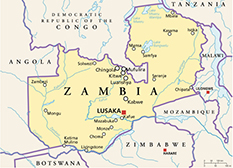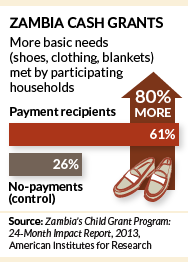Impact Evaluation of Zambia’s Child Grant Program
Zambia’s Child Grant cash transfer program (CGP) provides grants directly to poor households with children under five years old, empowering families to decide how best to meet their needs, beginning in the three districts with the highest rates of mortality, morbidity, stunting, and wasting.
Program Details
 Along with the implementing government ministry, UNICEF commissioned AIR to conduct an impact evaluation of the CGP to estimate its effect on an array of outcomes, including child nutrition, health, education, women’s empowerment, and productivity. This evaluation also includes a process analysis and cost-effectiveness study designed to answer questions related to program efficiency and effectiveness. AIR is implementing a four-year randomized control trial (RCT) to measure the impacts of the CGP. The evaluation includes household and community surveys, as well as qualitative focus groups and interviews with beneficiaries, community leaders, and program implementers.
Along with the implementing government ministry, UNICEF commissioned AIR to conduct an impact evaluation of the CGP to estimate its effect on an array of outcomes, including child nutrition, health, education, women’s empowerment, and productivity. This evaluation also includes a process analysis and cost-effectiveness study designed to answer questions related to program efficiency and effectiveness. AIR is implementing a four-year randomized control trial (RCT) to measure the impacts of the CGP. The evaluation includes household and community surveys, as well as qualitative focus groups and interviews with beneficiaries, community leaders, and program implementers.
AIR also designed and is managing the management information system (MIS) to monitor all beneficiaries. The MIS will improve the research capacity of the Zambian government. The CGP evaluation is one of the largest and longest RCTs of a cash transfer program in Africa. The CGP evaluation includes 2,500 households followed over four years with five rounds of data collection.
Findings
 We learned that the overall impacts of the program sums to a value that is greater than the transfer size. The program was originally designed with the transfer size equal to roughly one additional meal a day for the average family for one month. However, we find that in addition to eating more meals and being more food secure, families are also improving their housing conditions, buying more livestock, buying necessities for children, reducing their debt, and investing in productive activities.
We learned that the overall impacts of the program sums to a value that is greater than the transfer size. The program was originally designed with the transfer size equal to roughly one additional meal a day for the average family for one month. However, we find that in addition to eating more meals and being more food secure, families are also improving their housing conditions, buying more livestock, buying necessities for children, reducing their debt, and investing in productive activities.
Monetizing and aggregating these consumption and non-consumption spending impacts of the program gives an estimated multiplier of 1.49. These multiplier effects are derived in part through increased productive activity, including diversification of income sources into off-farm wage labor and non-farm enterprise, the latter mostly managed by women.
Unconditional cash transfer programs are often criticized for being a "handout," leading to dependency and reducing work; the multiplier effect appears to put these concerns to rest. Far from inducing dependency, the CGP allowed households to become more productive and ultimately increase their total expenditure by an amount greater than the transfer itself.
The evidence AIR generated from this study contributed to a decision by the Zambian government to scale-up a version of the program nationally, making cash transfers the country’s largest social protection program.
